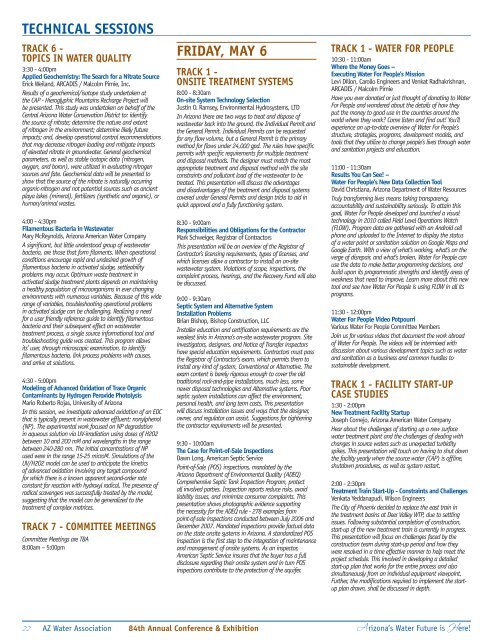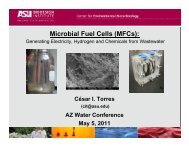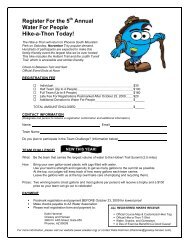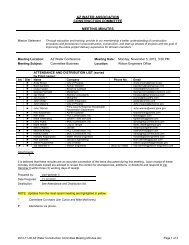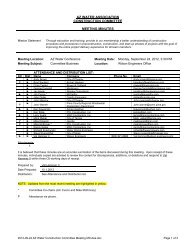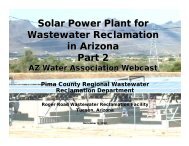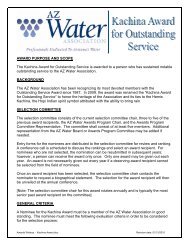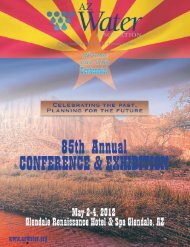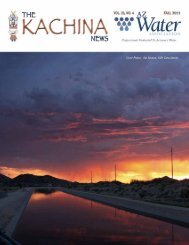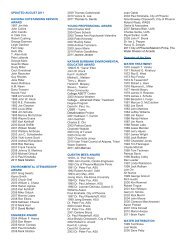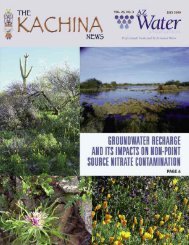Annual Conference Brochure - AZ Water Association
Annual Conference Brochure - AZ Water Association
Annual Conference Brochure - AZ Water Association
Create successful ePaper yourself
Turn your PDF publications into a flip-book with our unique Google optimized e-Paper software.
TECHNICAL SESSIONS<br />
TRACK 6 -<br />
TOPICS IN WATER QUALITY<br />
3:30 - 4:00pm<br />
Applied Geochemistry: The Search for a Nitrate Source<br />
Erick Weiland, ARCADIS / Malcolm Pirnie, Inc.<br />
Results of a geochemical/isotope study undertaken at<br />
the CAP - Hieroglyphic Mountains Recharge Project will<br />
be presented. This study was undertaken on behalf of the<br />
Central Arizona <strong>Water</strong> Conservation District to: identify<br />
the source of nitrate; determine the nature and extent<br />
of nitrogen in the environment; determine likely future<br />
impacts; and, develop operational control recommendations<br />
that may decrease nitrogen loading and mitigate impacts<br />
of elevated nitrate in groundwater. General geochemical<br />
parameters, as well as stable isotopic data (nitrogen,<br />
oxygen, and boron), were utilized in evaluating nitrogen<br />
sources and fate. Geochemical data will be presented to<br />
show that the source of the nitrate is naturally occurring<br />
organic-nitrogen and not potential sources such as ancient<br />
playa lakes (mineral), fertilizers (synthetic and organic), or<br />
human/animal wastes.<br />
4:00 - 4:30pm<br />
Filamentous Bacteria in Wastewater<br />
Mary McReynolds, Arizona American <strong>Water</strong> Company<br />
A significant, but little understood group of wastewater<br />
bacteria, are those that form filaments. When operational<br />
conditions encourage rapid and undesired growth of<br />
filamentous bacteria in activated sludge, settleability<br />
problems may occur. Optimum waste treatment in<br />
activated sludge treatment plants depends on maintaining<br />
a healthy population of microorganisms in ever changing<br />
environments with numerous variables. Because of this wide<br />
range of variables, troubleshooting operational problems<br />
in activated sludge can be challenging. Realizing a need<br />
for a user friendly reference guide to identify filamentous<br />
bacteria and their subsequent effect on wastewater<br />
treatment process, a single source informational tool and<br />
troubleshooting guide was created. This program allows<br />
its’ user, through microscopic examination, to identify<br />
filamentous bacteria, link process problems with causes,<br />
and arrive at solutions.<br />
4:30 - 5:00pm<br />
Modeling of Advanced Oxidation of Trace Organic<br />
Contaminants by Hydrogen Peroxide Photolysis<br />
Mario Roberto Rojas, University of Arizona<br />
In this session, we investigate advanced oxidation of an EDC<br />
that is typically present in wastewater effluent: nonylphenol<br />
(NP). The experimental work focused on NP degradation<br />
in aqueous solution via UV-irradiation using doses of H2O2<br />
between 10 and 200 mM and wavelengths in the range<br />
between 240-280 nm. The initial concentrations of NP<br />
used were in the range 15-25 microM. Simulations of the<br />
UV/H2O2 model can be used to anticipate the kinetics<br />
of advanced oxidation involving any target compound<br />
for which there is a known apparent second-order rate<br />
constant for reaction with hydroxyl radical. The presence of<br />
radical scavengers was successfully treated by the model,<br />
suggesting that the model can be generalized to the<br />
treatment of complex matrices.<br />
TRACK 7 - COMMITTEE MEETINGS<br />
Committee Meetings are TBA<br />
8:00am – 5:00pm<br />
22<br />
FRIDAY, MAY 6<br />
TRACK 1 -<br />
ONSITE TREATMENT SYSTEMS<br />
8:00 - 8:30am<br />
On-site System Technology Selection<br />
Justin O. Ramsey, Environmental Hydrosystems, LTD<br />
In Arizona there are two ways to treat and dispose of<br />
wastewater back into the ground, the Individual Permit and<br />
the General Permit. Individual Permits can be requested<br />
for any flow volume, but a General Permit is the primary<br />
method for flows under 24,000 gpd. The rules have specific<br />
permits with specific requirements for multiple treatment<br />
and disposal methods. The designer must match the most<br />
appropriate treatment and disposal method with the site<br />
constraints and pollutant load of the wastewater to be<br />
treated. This presentation will discuss the advantages<br />
and disadvantages of the treatment and disposal systems<br />
covered under General Permits and design tricks to aid in<br />
quick approval and a fully functioning system.<br />
8:30 - 9:00am<br />
Responsibilities and Obligations for the Contractor<br />
Mark Schweiger, Registrar of Contractors<br />
This presentation will be an overview of the Registrar of<br />
Contractor’s licensing requirements, types of licenses, and<br />
which licenses allow a contractor to install an on-site<br />
wastewater system. Violations of scope, inspections, the<br />
complaint process, hearings, and the Recovery Fund will also<br />
be discussed.<br />
9:00 - 9:30am<br />
Septic System and Alternative System<br />
Installation Problems<br />
Brian Bishop, Bishop Construction, LLC<br />
Installer education and certification requirements are the<br />
weakest links in Arizona’s on-site wastewater program. Site<br />
investigators, designers, and Notice of Transfer inspectors<br />
have special education requirements. Contractors must pass<br />
the Registrar of Contractor’s exam, which permits them to<br />
install any kind of system, Conventional or Alternative. The<br />
exam content is barely rigorous enough to cover the old<br />
traditional rock-and-pipe installations, much less, some<br />
newer disposal technologies and Alternative systems. Poor<br />
septic system installations can affect the environment,<br />
personal health, and long term costs. This presentation<br />
will discuss installation issues and ways that the designer,<br />
owner, and regulator can assist. Suggestions for tightening<br />
the contractor requirements will be presented.<br />
9:30 - 10:00am<br />
The Case for Point-of-Sale Inspections<br />
Dawn Long, American Septic Service<br />
Point-of-Sale (POS) inspections, mandated by the<br />
Arizona Department of Environmental Quality (ADEQ)<br />
Comprehensive Septic Tank Inspection Program, protect<br />
all involved parties. Inspection reports reduce risks, avoid<br />
liability issues, and minimize consumer complaints. This<br />
presentation shows photographic evidence supporting<br />
the necessity for the ADEQ rule - 278 examples from<br />
point-of-sale inspections conducted between July 2006 and<br />
December 2007. Mandated inspections provide factual data<br />
on the state onsite systems in Arizona. A standardized POS<br />
inspection is the first step to the integration of maintenance<br />
and management of onsite systems. As an inspector,<br />
American Septic Service insures that the buyer has a full<br />
disclosure regarding their onsite system and in turn POS<br />
inspections contribute to the protection of the aquifer.<br />
TRACK 1 - WATER FOR PEOPLE<br />
10:30 - 11:00am<br />
Where the Money Goes –<br />
Executing <strong>Water</strong> For People’s Mission<br />
Levi Dillon, Carollo Engineers and Venkat Radhakrishnan,<br />
ARCADIS / Malcolm Pirnie<br />
Have you ever donated or just thought of donating to <strong>Water</strong><br />
For People and wondered about the details of how they<br />
put the money to good use in the countries around the<br />
world where they work? Come listen and find out! You’ll<br />
experience an up-to-date overview of <strong>Water</strong> For People’s<br />
structure, strategies, programs, development models, and<br />
tools that they utilize to change people’s lives through water<br />
and sanitation projects and education.<br />
11:00 - 11:30am<br />
Results You Can See! –<br />
<strong>Water</strong> For People’s New Data Collection Tool<br />
David Christiana, Arizona Department of <strong>Water</strong> Resources<br />
Truly transforming lives means taking transparency,<br />
accountability and sustainability seriously. To attain this<br />
goal, <strong>Water</strong> For People developed and launched a visual<br />
technology in 2010 called Field Level Operations Watch<br />
(FLOW). Program data are gathered with an Android cell<br />
phone and uploaded to the Internet to display the status<br />
of a water point or sanitation solution on Google Maps and<br />
Google Earth. With a view of what’s working, what’s on the<br />
verge of disrepair, and what’s broken, <strong>Water</strong> For People can<br />
use the data to make better programming decisions, and<br />
build upon its programmatic strengths and identify areas of<br />
weakness that need to improve. Learn more about this new<br />
tool and see how <strong>Water</strong> For People is using FLOW in all its<br />
programs.<br />
11:30 - 12:00pm<br />
<strong>Water</strong> For People Video Potpourri<br />
Various <strong>Water</strong> For People Committee Members<br />
Join us for various videos that document the work abroad<br />
of <strong>Water</strong> For People. The videos will be intermixed with<br />
discussion about various development topics such as water<br />
and sanitation as a business and common hurdles to<br />
sustainable development.<br />
TRACK 1 - FACILITY START-UP<br />
CASE STUDIES<br />
1:30 - 2:00pm<br />
New Treatment Facility Startup<br />
Joseph Cornejo, Arizona American <strong>Water</strong> Company<br />
Hear about the challenges of starting up a new surface<br />
water treatment plant and the challenges of dealing with<br />
changes in source waters such as unexpected turbidity<br />
spikes. This presentation will touch on having to shut down<br />
the facility yearly when the source water (CAP) is offline,<br />
shutdown procedures, as well as system restart.<br />
2:00 - 2:30pm<br />
Treatment Train Start-Up - Constraints and Challenges<br />
Venkata Yeddanapudi, Wilson Engineers<br />
The City of Phoenix decided to replace the east train in<br />
the treatment basins at Deer Valley WTP, due to settling<br />
issues. Following substantial completion of construction,<br />
start-up of the new treatment train is currently in progress.<br />
This presentation will focus on challenges faced by the<br />
construction team during start-up period and how they<br />
were resolved in a time effective manner to help meet the<br />
project schedule. This involved in developing a detailed<br />
start-up plan that works for the entire process and also<br />
simultaneously from an individual equipment viewpoint.<br />
Further, the modifications required to implement the startup<br />
plan drawn, shall be discussed in depth.<br />
<strong>AZ</strong> <strong>Water</strong> <strong>Association</strong> 84th <strong>Annual</strong> <strong>Conference</strong> & Exhibition Arizona’s <strong>Water</strong> Future is Here!


